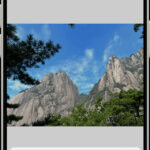In today’s digital age, sharing photos is a common task. Whether you’re sending a portfolio to a client, archiving precious memories, or simply compiling images for easy viewing, converting photos to PDF format offers a versatile solution. PDFs ensure your images are displayed consistently across different devices and operating systems, maintaining their quality and layout. If you’re a Mac user wondering how to make a photo PDF, you’re in luck! macOS provides two straightforward methods to achieve this: using the built-in Preview app and leveraging the powerful Automator tool. This guide will walk you through both processes, ensuring you can easily convert your photos to PDF in no time.
Method 1: Using Preview – The Quick and Easy Way
For a fast and simple photo to PDF conversion, macOS’s Preview application is your go-to tool. Preview is the default image and PDF viewer on Macs, and it comes equipped with a handy feature to create PDFs directly from images. This method is ideal for quickly converting single or multiple photos into separate PDF pages.
Here’s how to make a photo PDF using Preview:
-
Open your photo(s) with Preview: Select the image files you want to convert. You can select multiple images by holding down the Command key while clicking on each file. Right-click on your selected images and choose Open with > Preview.
-
Select Image Thumbnails in Preview: Once your images are open in Preview, ensure the sidebar is visible (if not, go to View > Sidebar > Show Sidebar). In the sidebar, you’ll see thumbnails of all opened images. To convert specific images to PDF, select their thumbnails in the sidebar. To convert all opened images, select all thumbnails (Command + A).
-
Print Selected Images to PDF: With the thumbnails selected, navigate to File > Print Selected Images… (Note: It’s crucial to choose “Print Selected Images…” if you’ve selected specific thumbnails; otherwise, just “Print…” will work if you want to convert all open images).
-
Save as PDF: In the Print dialog window that appears, look for the PDF dropdown menu in the bottom-left corner. Click on it and select Save as PDF….
-
Choose Save Location and Name: A save dialog box will appear, allowing you to choose where to save your new PDF file and give it a name. Select your desired location, enter a filename, and click Save.
That’s it! You’ve successfully created a PDF from your photo(s) using Preview. Each selected image will be converted into a separate page within the PDF document.
Method 2: Leveraging Automator for Advanced PDF Creation
While Preview is excellent for quick conversions, Automator offers a more powerful and automated approach, especially when dealing with multiple photos or repetitive tasks. Automator is macOS’s built-in automation application, allowing you to create workflows for various tasks, including creating PDFs from images. This method is particularly useful if you frequently need to convert photos to PDFs, as you can save your workflow for future use.
Here’s how to make a photo PDF using Automator:
-
Open Automator: Launch Automator by searching for it in Spotlight (Command + Spacebar and type “Automator”) or finding it in your Applications folder.
-
Choose Workflow Type: When Automator opens, you’ll be prompted to choose a type of document. Select Workflow and click Choose.
-
Add “Get Specified Finder Items” Action: In the Automator library (left sidebar), navigate to Files & Folders and find the Get Specified Finder Items action. Drag this action to the workflow area on the right, or double-click to add it.
-
Add “New PDF from Images” Action: Next, in the Automator library, go to PDFs and find the New PDF from Images action. Drag this action below the “Get Specified Finder Items” action in your workflow.
-
Configure “New PDF from Images” Action: In the “New PDF from Images” action, you can configure several options:
- Save Output to: Choose the location where you want to save the generated PDF file. You can select “Desktop”, “Documents”, or any other folder.
- Output File Name: Specify a name for your PDF file. You can enter a custom name or leave it blank to be prompted when you run the workflow.
- (Optional) Adjust Photo Sizes: You can adjust the page size and image scaling options if needed, but for most cases, the default settings work well to maintain the original photo dimensions within the PDF page.
-
(Optional) Add “Open Finder Items” Action: If you want to automatically open the newly created PDF after it’s generated, add the Open Finder Items action (found in Files & Folders in the library) at the end of your workflow. This can be helpful for quickly reviewing the result.
-
Add Photos to Workflow: In the “Get Specified Finder Items” action, click the Add button to select the photo files you want to convert to PDF. You can also drag and drop photo files directly into the action box.
-
Run the Workflow: Click the Run button in the top-right corner of the Automator window to execute the workflow. Automator will process the images and create a PDF file in your specified location. If you added the “Open Finder Items” action, the PDF will automatically open in Preview or your default PDF viewer.
-
(Optional) Save the Workflow: To save this workflow for future use, go to File > Save. Give your workflow a descriptive name (e.g., “Photos to PDF Converter”) and choose where to save it. Saved Automator workflows can be easily accessed and run again whenever you need to convert photos to PDF.
By using Automator, you’ve not only created a photo PDF but also potentially streamlined your workflow for future conversions. This method is particularly efficient for batch processing and for users who frequently perform this task.
Conclusion
Converting photos to PDF on a Mac is a straightforward process, thanks to the built-in tools macOS provides. Whether you opt for the quick and simple Preview method or the more automated and versatile Automator approach, you can easily create PDFs from your images to suit various needs. For single, quick conversions, Preview is incredibly convenient. However, for frequent conversions or batch processing, Automator offers a more efficient and customizable solution. Choose the method that best fits your workflow and start converting your photos to PDFs today!

